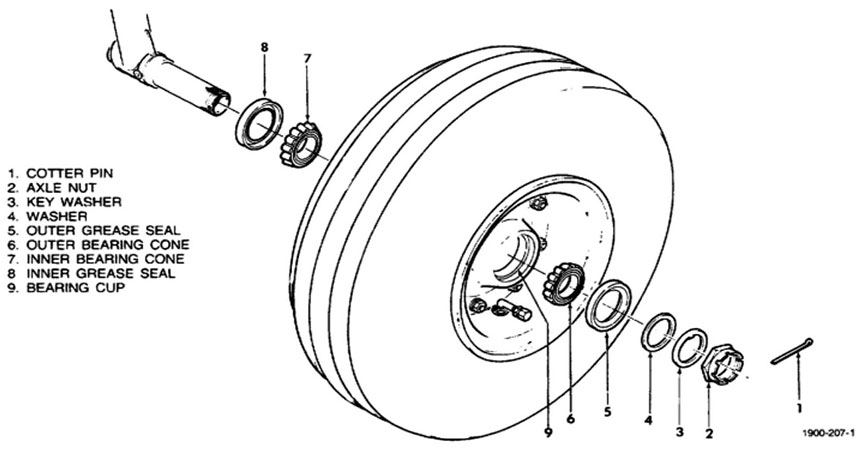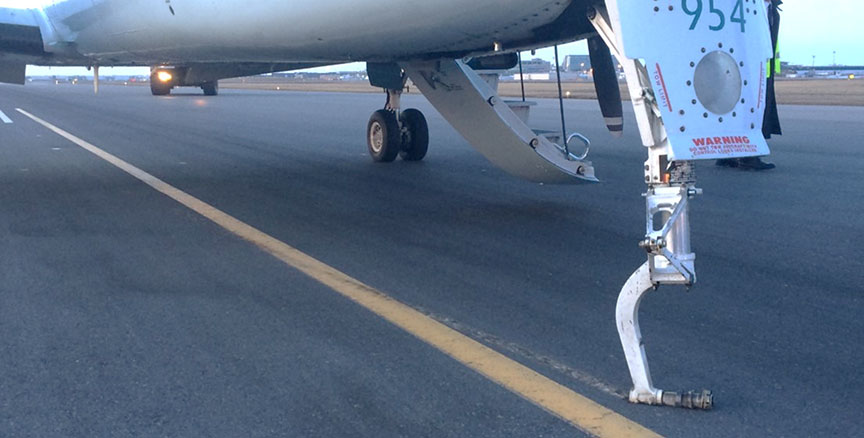Loss of nose wheel on touchdown
Air Georgian Ltd.
Beechcraft 1900D, C-GZGA
Calgary International Airport, Alberta
The Transportation Safety Board of Canada (TSB) investigated this occurrence for the purpose of advancing transportation safety. It is not the function of the Board to assign fault or determine civil or criminal liability. This report is not created for use in the context of legal, disciplinary or other proceedings. See Ownership and use of content. Masculine pronouns and position titles may be used to signify all genders to comply with the Canadian Transportation Accident Investigation and Safety Board Act (S.C. 1989, c. 3).
History of the flight
On 09 April 2018, the Air Georgian Ltd. Beechcraft 1900D aircraft (registration C-GZGA, serial number UE-306) operating as flight 7228 (GGN7228) from Cranbrook/Canadian Rockies International Airport (CYXC), British Columbia, to Calgary International Airport (CYYC), Alberta, departed at 1910Footnote 1 with 2 flight crew members and 8 passengers on board. The captain, seated in the left seat, was the pilot flying; the first officer, seated in the right seat, was the pilot monitoring.
While the aircraft was taxiing, an unusual noise was heard coming from the airframe. The captain thought there was a possibility that ice had accumulated in the main landing gear brake assemblies, so he turned on the brake de-ice system. Once he noticed that the outside air temperature was 10 °C, the system was turned off. By this time, the aircraft had back-taxied on Runway 16 and, while the aircraft was turning around, the noise stopped. Because the noise stopped, both the captain and the first officer thought that the issue had been resolved and carried out a normal takeoff from Runway 16.
As the aircraft was climbing toward 15 000 feet above sea level (ASL), the captain noticed that the landing gear in-transit light was on. Arrangements were made with air traffic control to level off at 17 000 feet ASL, and speed was reduced to allow for the operation of the landing gear. The landing gear was selected to the down position and 3 green down-and-locked light indications were obtained. The captain then selected the landing gear up.
While the landing gear was retracting, an unusual sound was heard. All the landing gear lights went out, indicating that the landing gear was up and locked.
The flight proceeded to CYYC, using the VESGA FOUR ARR arrival route for Runway 17R. The crew discussed the possibility of a landing gear issue and planned to land as smoothly as possible. The aircraft touched down approximately 3000 feet down the runway, just before the intersection with Runway 11/29. The touchdown on the main wheels was smooth, but, as the nose wheel touched the runway, there was an immediate shimmy followed by a drop in the pitch attitude when the nose wheel became separated from the nose wheel assembly. A grinding noise was heard and the tower controller informed the crew that sparks were coming from the front of the aircraft.
The crew declared an emergency. Once the aircraft came to a stop on the runway, the passengers were evacuated via the main cabin door and taken to the terminal by an airport shuttle bus. There were no injuries, and there was no fire. The emergency locater transmitter did not activate.
Distribution of aircraft parts
The day after the occurrence flight departed CYXC, the airport authority found remnants of wheel bearings on Runway 16. At CYYC, the nose wheel was found in the grass to the right of Runway 17R, and maintenance staff found the remains of nose wheel bearings on the runway. The axle nut, key washer, washer, and cotter pin (Figure 1) remained attached to the axle.
Damage to the aircraft
The aircraft sustained damage to the lower nose landing gear assembly. There was damage to the opening of the nose landing gear bay because the displaced nose wheel had come into contact with it during the retraction cycles. The valve stem side of the nose wheel half bearing recess had been completely reamed out, allowing the wheel to slide over the retaining hardware. The aircraft slid approximately 1200 feet down Runway 17R after the nose wheel separated from the axle, leaving a scar in the runway surface. The axle and the heel of the lower nose landing gear casting were ground down to half of their normal diameter (Figure 2).
Weather
The weather at CYYC at 1900 was reported as 10 miles visibility, a scattered layer of cloud at 10 000 feet ASL, and a broken layer of cloud at 28 000 feet ASL. The temperature was 5 °C with a dew point of −3 °C. The altimeter setting was stable at 29.98 inHg. Weather was not a factor in this incident.
Industry standards for servicing bearings
It is accepted practice in aircraft maintenance that before in-service bearings are inspected and relubricated, they are to be cleaned using an acceptable solvent, then dried. This allows for a thorough and accurate inspection of the bearing to determine its suitability for continued service. Various technical manualsFootnote 2 Footnote 3 describe similar procedures to be used for wheel inspection, including bearing cleaning, inspection, and lubrication.
More specifically, the manual used by the training institution attended by the aircraft maintenance engineer who performed the work on the occurrence aircraft states the following:
Footnote 4In order for an aircraft maintenance engineer to determine the suitability for service, the bearing set—both the bearing and the cone—must be clean and dry. Once a determination of suitability has been made, the bearing can be serviced with the specified grease.
Service interval for bearings
With respect to service intervals for wheel bearing lubrication, the Beechcraft 1900D maintenance manual states the following:
sic Footnote 5The Air Georgian Additional Work Requirement -017 (MPM-AWR-017) FormFootnote 6 provides detailed instructions on how to clean, inspect, and service the nose wheel bearing set. The form was published in 2012 and increased the interval between servicing of the nose wheel bearing from 200 hours to 600 hours. The investigation was unable to find any documentation relating to the increased inspection interval, which represents a 200% increase. Nor could the investigation find any record of the regulator approving this increase, as stipulated by the Air Georgian–approved large aircraft maintenance schedule.Footnote 7
Maintenance history of the occurrence nose wheel bearing set
The nose wheel assembly consists of 2 aluminum wheel halves and the tire. When the assembly is broken down for a tire change and bearing service, a non-destructive test is carried out and the parts are inspected for nicks and cracks that would render the wheel half unserviceable. The occurrence nose wheel assembly had been sent out for a tire change and wheel half inspection 680 hours prior to the occurrence. At that inspection, 1 wheel half failed the inspection and was replaced. The maintenance record notes that the bearings were removed, inspected, and serviced in accordance with the aircraft maintenance manual.
At 81.5 hours prior to the occurrence, the nose bearing set was serviced at the Air Georgian maintenance base at CYYC. The investigation learned that the MPM-AWR-017 form was signed off during this service, but the procedure used did not follow the instructions provided on the form. New grease was used to push out the old grease and no cleaning or detailed inspection of the bearing was carried out. The old grease was then inspected for contamination. The bearings were rotated to check for freedom of movement and then installed. The investigation learned that although the company procedure reflects the manufacturer's requirement, the aircraft maintenance engineer who performed the work on the occurrence aircraft adapted one of the elements of the procedure.
Key safety message
As shown in this occurrence, when specific instructions regarding maintenance activities are not followed, component failure can occur, exposing the crew and passengers to additional hazards.
Safety action taken
Air Georgian has taken the following actions in response to this occurrence:
- The work card has been modified to provide clearer guidance and additional notes referencing the bearing-cleaning methodology.
- A general (all maintenance employees) Maintenance Technical Bulletin was published describing cleaning, inspection, and lubrication best practices. The bulletin was to be posted for 6 months and required that all maintenance employees sign off after having read it.
- The aircraft maintenance engineer who performed the work was coached on the proper procedure to follow.
This concludes the TSB's limited-scope investigation into this occurrence. The Board authorized the release of this investigation report on . It was officially released on .

